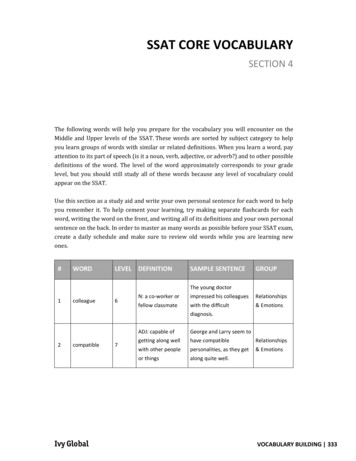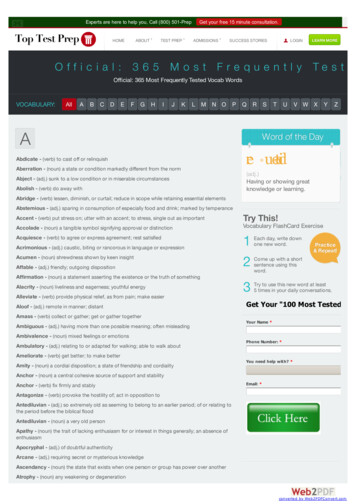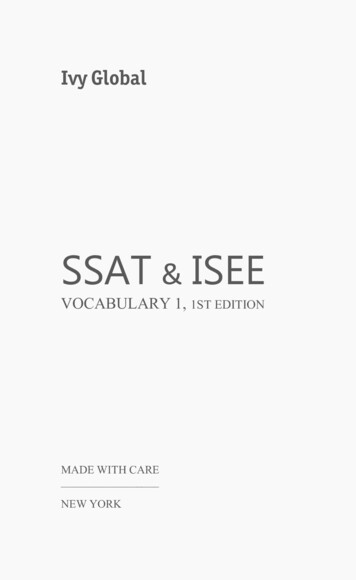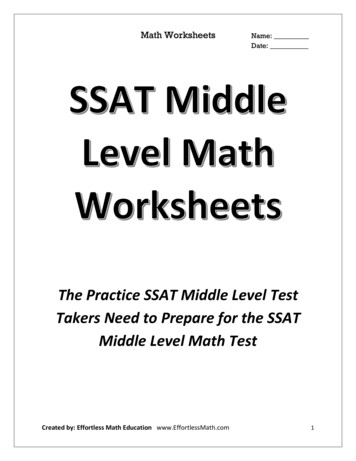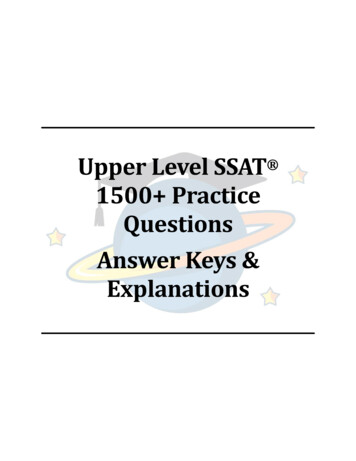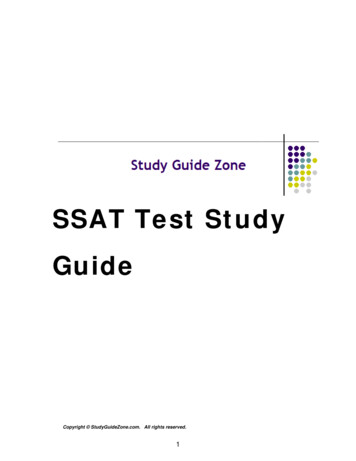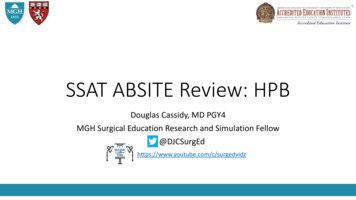
Transcription
SSAT ABSITE Review: HPBDouglas Cassidy, MD PGY4MGH Surgical Education Research and Simulation dz1/7/20211
Content Outline Liver AnatomyLiver AbscessesBenign Liver LesionsMalignant Liver LesionsLiver Failure Portal Hypertension Biliary Anatomy and PhysiologyBile Duct InjuryBenign Biliary PathologyBile Duct and Gallbladder Cancer Pancreas Anatomy, Embryology, andPhysiology Acute Pancreatitis Chronic Pancreatitis Cystic Lesions of the Pancreas Pancreatic Adenocarcinoma Neuroendocrine Tumors of thePancreas3
Left LiverRight Liver4a2Extended Right Hepatectomy8Extended Left Hepatectomy1Superior (II)7Inferior (III)Posterior(VI, VII)34b5Anterior(V, VIII)Left Medial(IV)Left Lateral (II, III)164
Right LiverLiver AnatomyLeft LiverExtended Right HepatectomyExtended Left Hepatectomy Divided into functional right and leftlobes by Cantlie’s line Cantlie’s Line: vertical plane extendingfrom the middle of the gallbladder fossa tothe IVC Right Lobe (segments V-VIII) Divided into anteromedial (V, VIII) andposterolateral (VI, VII) segments by theright hepatic vein (right scissura)Superior (II)Inferior (III)Posterior(VI, VII)Anterior(V, VIII)Left Medial (IV)Left Lateral (II, III) Left Lobe (segments II-IV) Divided into an left medial (IV) and leftlateral (II III) segment by the umbilicalfissure Left lateral segment: divided by the lefthepatic vein (left scissura) Caudate Lobe (I): receives separate rightand left portal and arterial inflow; drainsdirectly into the retrohepatic IVCLeft Hepatectomy: segments 2, 3, 4Right Hepatectomy: segments 5, 6, 7, 8Left Trisegmentectomy: segments 2, 3, 4, 5, 8Right Trisegmentectomy: segments 4, 5, 6, 7, 8Left Lateral Segmentectomy: segments 2, 35
Liver Abscesses Pyogenic Most common; GNRs (#1 E. coli, #2, K. pneumoniae) Direct spread from biliary tree (#1) CT: peripheral enhancing, central hypoattenuating, multi-loculated (vs. amebic) FNA with WBCs /- organisms Tx: percutaneous drainage Abx Amebic Epi: male predominant; hx of travel (Central/South America) Pathogen: E. histolytica (fecal-oral); Abs CT: well-defined hypoattenuating lesion with peripheral wall of enhancing edema Central localized hepatic necrosis (no organisms on FNA) Tx: metronidazole; drainage if poor response/superinfection Echinococcal Epi: endemic to Mediterranean, East Africa, Middle East, South America, Asia Pathogen: E. granulosus; fecal-oral; eosinophilia, serology, Casoni CT: hypoattenuating lesion, septae/daughter cysts (75%), /- peripheralcalcifications (50%) Pericyst, ectocyst, endocyst (germinal layer -- gives rise to daughter cysts) Tx: albendazole, PAIR/surgical resection6
Benign Liver Lesions Hemangioma Epi: most common benign tumor; F M (3:1) CT: late contrast puddling is pathognomonic PERIPHERAL enhancement on ARTERIAL phase CENTRIPETAL filling on PORTAL VENOUS phase Retention of contrast on washout or delayed phase Tx: angioembolization for bleeding; enucleation if symptomatic Hepatic Adenoma Epi: female predominant; hormonally sensitive (OCPs, steroids) Risk of bleeding and malignant transformation CT: well-marginated, isointense on NC CT; HYPERINTENSE on ARTERIAL phase; rapid washout; /- heterogenous due to hemorrhage No Eovist (Gd) [MRI] or sulfur colloid [NM scan] retention (no Kupffer cells) Tx: discontinue offending agent; resection if 5cm, symptomatic Focal Nodular Hyperplasia (FNH) No risk of bleeding or malignant transformation CT: homogenous mass with CENTRAL scar; HYPERINTENSE on ARTERIAL phase Central Scar: hypoattenuating on arterial phase; hyperattenuating on delay Eovist (Gd) and sulfur colloid uptake ( Kupffer cells) Tx: observation7
Malignant Liver Lesions Hepatocellular Carcinoma Most common primary hepatic malignancy HBV infection #1 cause worldwide; 80% in setting of cirrhosis Screening: AFP ultrasound every 6 months for AT RISKPATIENTS CT: primarily arterial inflow Heterogenous; Early arterial enhancement and washout ofcontrast on delayed phase Tx: resection/ablation (if localized and adequate remnant),OLT (Milan criteria), sorafenib (metastatic/unresectable) Metastatic Liver Tumors More common than primary liver tumor (20:1) CT: Hypoattenuating on NC CT compared to liver;hypovascular lesions with minimal arterial enhancement8
Liver giomaHypointense to liverPeripheral enhancementCentripetal fillingRetention of contrastFocal NodularHyperplasiaIsointense to the liverHomogenous lesionRapid homogenousenhancement w/hypoattenuating centralscarRapid washoutIsointense w/ delayedenhancement ofcentral scarHepatic AdenomaIsointense to the liverHeterogenous (bleed,necrosis, fat)Rapid enhancementRapid washoutIsointense to liverHCCIsointense/hypointenseto liverHomogenous rapidenhancementRapid washoutIsointenseMetastasesHypointenseHyperintense (NET)Hypointense (CRC)Central filling (CRC)Washout9
ArterialPortalVenousDelayedBenign LesionsMalignant Lesions10
Liver Failure and Portal Hypertension Portal HTN Dx: hepatic venous pressure gradient (HVPG): pressure gradientbetween the wedge hepatic venous pressure (WHVP) and thefree hepatic venous pressures Estimate of pressure gradient between PV and IVC Portal HTN: HVPG greater than or equal to 5mmHg; clinicallysignificant when 10mmHg Liver Failure Causes: Pre-hepatic, Intrahepatic, Post-hepatic Intrahepatic: pre-sinusoidal, sinusoidal, post-sinusoidal Child’s Pugh Score: Components: total bilirubin, PT/INR, albumin, ascites, encephalopathy MELD Score: Components: total bilirubin, PT/INR, creatinine11
Biliary Anatomy and Physiology Physiology Bile salts: primary bile salts (cholic and chenodeoxycholic acid) producedfrom cholesterol; conjugated in liver (taurine, glycine) 95% reabsorbed in terminal ileum Bilirubin: produced by breakdown of senescent RBCs and metabolism ofheme Conjugated in liver by UDP-glucuronyl transferase 90% excreted in stool (stercobilin), 10% reabsorbed (urobilinogen) Anatomy Cystic artery: arises from right hepatic artery, travels posterior to CHD andthrough triangle of Calot 10% double cystic artery CBD: segmental blood supply; runs at 3 and 9 o’clock12
Biliary Obstruction Causes: **Choledocholithiasis**, benign biliary strictures, malignantbiliary structures, choledochal cysts, extrinsic compression,etc. Cholangitis: Charcot triad of fever, RUQ pain, andjaundice Reynolds Pentad: hypotension and altered mental status Managing CBD Stones: Endoscopic Retrograde Cholangiopancreatography (ERCP) Intraoperative Cholangiogram (IOC) Saline Flush Glucagon (1-2 mg) Transcystic CBD exploration (choledochoscope, baskets,Fogarty catheters) CONTRAINDICATIONS: small duct, numerous stones, large stones Choledochotomy and CBD exploration (lap vs. open)13
Bile Duct Injury Critical View of Safety (CVS): Hepatocystic triangle is cleared at fat/fibrous tissue Lower thirds of GB is separated from the liver Two and only two structures are seen entering thegallbladder Cause of injury: excessive cephalad retraction offundus aligns the cystic duct and CBD which aresubsequently mistaken Work-up: abdominal U/S; consider CT vs. MRCP Management: Intra-op: Short segment: primary repair over T-tube Long segment: hepaticojejunostomy Drainage and transfer to HPB center Post-op: Goal is to control sepsis and control drainage prior to delayreconstruction Percutaneous transhepatic cholangiography (PTC): defines theanatomy of the PROXIMAL biliary tree for surgical reconstructionAND decompress the biliary system14
Bile Duct Injury Bismuth-Strasberg Classification: A: leak from cystic duct stump or accessory duct of Luschka -- ERC endobiliary stent placement B: occlusion of ABERRANT right hepatic duct C: transection without ligation of aberrant right hepatic duct D: lateral injury to extrahepatic bile duct -- risk for stricture overtime E: complete disruption of biliary-enteric continuity due totransection, excision, and/or ligation E1: common hepatic duct; 2 cm from bifurcation E2: common hepatic duct; 2 cm from bifurcation E3: common hepatic duct at the bifurcation; no residual CHD butconfluence preserved E4: involvement of the confluence and loss of communication betweenthe right and left hepatic ducts E5: involvement of aberrant right hepatic duct /- CHD stricture15
Benign Biliary Pathologies Biliary Dyskinesia: motility disorder of GB that involves abnormalbiliary tract peristalsis muscle in response to dietary stimulation Dx: CCK-stimulated HIDA scan w/ diminished GB ejection fraction ( 33%) Tx: cholecystectomy Gallstone Ileus: mechanical intestinal obstruction from gallstoneafter fistulization of GB to duodenum Rigler’s Triad: intestinal obstruction, pneumobilia, aberrant gallstonelocation Tx: longitudinal enterotomy proximal to stone, removal stone andprimary transverse closure Gallbladder Adenomas: Polyps 10 mm, polyps (any size) stones, polyps PSC ---- cholecystectomy Polyps 6-9 mm ---- serial ultrasound monitoring16
Bile Duct and Gallbladder Cancer Cholangiocarcinoma: Arise from biliary epithelium; 3 distinct subclasses[intrahepatic, perihilar, distal] 3 distinct morphologic subtypes: sclerosing, nodular(MOST COMMON), papillary (BEST PROGNOSIS) Surgical Treatment:Bismuth-Corlette Classification of Perihilar Cholangiocarcinoma Intrahepatic: partial hepatectomy /- bile duct resection Roux-en-Y HJ Perihilar: distal duct excised for clear margins, CCY /hepatic resection with RnY HJ reconstruction Frozen section of proximal R/L hepatic ducts, RnY w/HJ OLT: for locally advanced perihilarcholangiocarcinoma Distal: pancreaticoduodenectomy Gallbladder Cancer: Risk Factors: cholelithiasis and chronic gallbladder inflammation Surgical Treatment Laparoscopic cholecystectomy adequate for Tis or T1a margin-negative GB cancers Tumors T1a require more extensive resection extended or radical cholecystectomy Partial hepatectomy (segments IVb/V) cholecystectomy regional lymphadenectomy Bile duct margin sent if ( ) extrahepatic bile duct resection to achieve negative cystic duct margin ( HJ reconstruction)17
Pancreas Anatomy, Embryology, and Physiology Pancreas Divisum: failure of fusion of the ventral and dorsal pancreaticducts Accessory duct of Santorini (dorsal bud) drains via minor papillae [body, tail,part of head] Major duct of Wirsung (ventral bud) drains via major papillae [uncinate, head] Majority asymptomatic, can present with pancreatitis Tx: ERCP papillotomy of minor papillae Annular Pancreas: aberrant migration of the ventral pancreatic bud -- extrinsic duodenal obstruction Tx: duodenal bypass; do not resect obstructing pancreatic segment Physiology: Secretin -- pancreatic fluid secretion Chloride secretion VARIES INVERSELY with bicarbonate secretion Sum of anions Sum of cations Vagal /CCK -- pancreatic enzyme secretion18
Acute Pancreatitis Acute Pancreatitis: Causes: gallstones (#1 in US) and EtOH Dx: need 2 of 3 Clinical presentation (epigastric pain, N/V, radiate to back) Lipase/amylase 3x upper level of normal CT findings consistent with pancreatitis Complications: Revised Atlanta Classification Pseudocyst: time vs. drainage (internal preferred) 6 weeks: 40% resolve; 6cm: 2/3 will need drainage Consider ERCP if not resolving (communication w/ main ductvs. downstream stricture) Tx: internal drainage Endoscopic cystogastrostomy, laparoscopic vs. opencyst-gastrostomy/enterostomy, distal pancreatectomy WOPN: step-up therapy [perc drainage, RP/transgastricdebridement]19
4 crotizingPancreatitisAcute PeripancreaticFluid Collections(APFC)Acute NecroticCollection (ANC) 4 weeksPancreaticPseudocystWalled Off PancreaticNecrosis (WOPN)
Chronic Pancreatitis Chronic Pancreatitis: Causes: EtOH (70-80%); hereditary (PRSS1 gene) Imaging: CT pancreas protocol, MRCP Inidcations: intractable pain, complications of pancreatitis Pseudocysts, pancreatic ascites, obstruction, neoplasia Surgery: determine need for resection vs. decompression(or both) Decompression:Beger procedure(duodenalpreservingpancreatic headresection) Puestow (lateral pancreaticojejunostomy) Resection: Whipple, Beger (DPPHR) – for isolated pancreatic head disease Distal pancreatectomy – for isolated pancreatic body / tail disease Total pancreatectomy and autologous islet cell txp (AIT) Combination: Frey – for isolated pancreatic head disease AND ductal dilatation21
Cystic Lesions of the Pancreas22
Cystic Lesions of the PancreasFeaturesLocationRisk ofAmylaseMalignancyCEAViscosityMucinCytologySCNF M (4:1); 60-70sThroughout“grandmother”No (-)Glycogen richMCNF M (9:1); 40-50s“mother”Body/Tail15% ( )Ovarian-typestromaSPTF; 40“daughter”Body/TailLow Solid /cystic(-)Necrotic cellsPseudocystN/AThroughoutNo / (-)Inflammatory( )Tall columnar,mucinproducingIPMNF M, 60-80sHead;MD: 60%Throughout BD: 2-10% Radiology23
Cystic Lesions of the Pancreas -- IPMNs IPMNs: Resect all MAIN DUCT IPMNs andBD-IPMNs with HIGH-RISK STIGMATA Enhancing solid component Main Duct (MD) 10 mm Proximal lesion with obstructive jaundice Worrisome features: NEED EUS /- FNA tostratify lesion Cyst 3cmThickened/Enhancing cyst wallMain duct 5-9 mmEnhancing mural noduleAbrupt change in pancreatic duct caliberLymphadenopathyHistory of pancreatitisGrowth 5 mm in 2 years CA 19-924
Pancreatic Adenocarcinoma Risk Factors: smoking; chronic pancreatitis, DM, obesity, genetics [CF, HNPCC,BRCA-2, Peutz-Jegher, Familial Pancreatitis] Pathogenesis: PanIN -- PDAC [95% KRAS mutation] Tumor Markers: CEA, CA19-9 (10-15% w/o CA19-9) Treatment: Whipple (head/neck); distal pancreatectomy splenectomy(body/tail) Complications: DGE, Pancreatic fistula/leak
4 8 5 4a 4b 7 6 2 3 1 1 Right Liver Left Liver Extended Left Hepatectomy Superior (II) Inferior (III) Extended Right Hepatectomy Anterior (V, VIII) Posterior (VI, VII)

